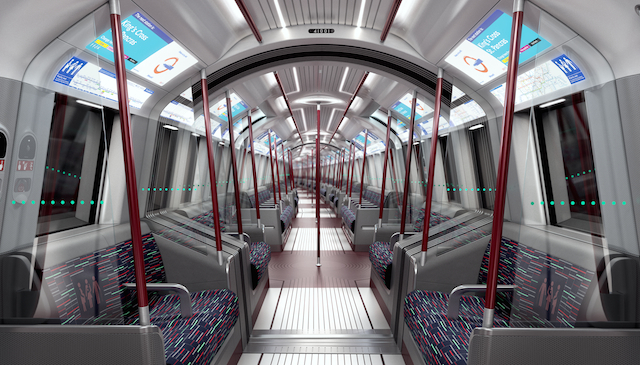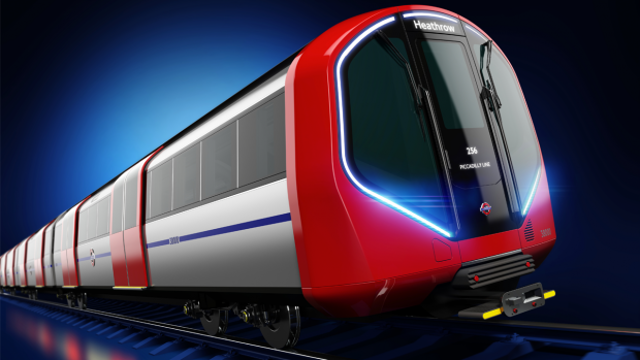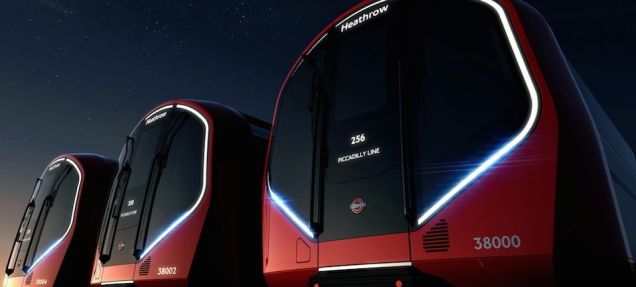“I remember going on the Tube trains when I was very young, and thinking ‘this is amazing’. The smell, the noise — the wooden floors, the wooden escalators of the time — incredible to think that we had those,” says Paul Priestman, director and co-founder of London design agency Priestmangoode.
It’s a sepia-toned memory of the London Underground, and one that stands slightly at odds with Priestmangoode’s latest project, the sci-fi tinged driverless Tube trains that will roll onto the capital’s transport network in the early 2020’s. “I’m not one for looking back or being ‘retro’. It’s not a museum, it’s a piece of highly efficient modern design,” says Priestman. “As long as it works well, then it can look nice. Styling that doesn’t work is bad design as far as I’m concerned.”
Indeed, the “New Tube for London” (as the project has been dubbed) is a thoroughly modern design, drawing from Priestmangoode’s extensive work in the aviation industry and its growing portfolio of overseas transport infrastructure clients.
With London’s population set to rise from 8.4 million today to more than 10 million by 2030, the Tube network will soon be bursting at the seams. Increasing the capacity of each train, then, became the first critical goal of the new design. Built as “through trains” (meaning that there are no doored divisions making up separate carriages), the Priestmangoode super carriage offers far more occupiable space than the current Tube, “ekeing back every square millimetre to the passenger,” according to Priestman.
There are also smart design choices implemented to reduce so-called “Dwell Time” — the duration it takes passengers to get on or off a train. For starters, all doors on the new Tube train will be double doors (equally spaced along the length of train), letting passengers board and depart more easily, while “personalised lighting” that is “bright but not institutionalised” will encourage passengers to move down into the carriage once aboard, making room for others.
Designing Out an Overcrowded Future
These changes should allow for considerable jumps in passenger numbers: the Central line capacity is expected to jump 25 per cent (up by 12,000 extra passengers per hour) when the new trains are introduced, while the Piccadilly Line will be able to move a massive 60 per cent more people at a time, up by 19,000 customers per hour.
With increased passenger numbers comes an increased need for visible, helpful information, and this will be provided by “dynamic” video displays, capable of showing both advertisements (obviously) and animated visual representations of where a Tube sits along its route, as well as, most helpfully, news on any potential delays.
But perhaps the feature most requested by all from commuters, and present in the design, is that of a concerted effort to reduce the heat that generates inside a cramped rush-hour carriage.
“There’s very little ventilation in the old platforms and trains,” explains Priestman, “and when you get down to some of the deep lines, they’re very warm because of the energy being put in by people and motors. There’s no way it can get out.”
This design approaches that issue in two ways. First, the longed-for introduction of an air-cooling system will increase air flow around a carriage, although note that it is not an air-conditioning system. Priestman couldn’t “go into the details” of the solution his company will be implementing just yet, so it will be interesting to see in time how they have managed to recycle the Tube’s dead air.

Second, the new trains will be far more green-friendly than their predecessors, putting less wasted, expended heat back into the Tube network by using the “latest motors”. They will also take advantage of cutting-edge braking methods that can harvest energy from the heat generated when slowing the weighty vehicle to a halt.
Building Brand Tube
Of course, this project is not just about cramming technology into every carriage. The Tube is an iconic part of London, the veins that carry the lifeblood of the city — its swelling population — from one corner of its vast expanse to the other. It, like the red London bus or the yellow New York taxi, is that rare thing: a mode of transport that doubles up as a tourist attraction. It was vital, then, that Priestman’s team came together for a design that was as recognisable in its “Londoness” as it was efficient and forward-thinking.
“We started by really studying what makes London,” says Priestman, “materials, finishes; cast iron railings, portland stone.
“You’ve got the Wren churches, which were almost like the first brands of London, uniting all these (at the time) disparate villages underneath grand spires. You’ve got the lovely roofs that go green, and then modern buildings like the Shard or Canary Wharf, where that tint of green is in the glass and steel. We bring those elements together as a palette.”
Taking on the Tube is at once both a coveted and unenviable task. On the one hand, it’s the chance to work on one of the world’s most iconic brands (“It is the brand of London,” notes Priestman, “you have kids with the T-shirt on in China. It’s the ‘London Tube’ — no one else calls their metro the ‘tube’.”)
Yet, on the other, it’s one of London’s most oft-criticised services — at least in its current form. But despite Londoners’ gripes with TFL or striking drivers, there’s an innate respect for the Tube, one that is found manifested in an unlikely place, according to Priestman: the trains’ upholstered seating.

“It’s interesting, as soft seating in New York would last five minutes,” he says. “In Paris they have hard seating, in Hong Kong they have hard seating, but in London, it does work. It’s extraordinary. And I think it has a lot to do with culture, and a lot to do with design.
“A design that has a friendliness to it has an intimacy to it, and while staffing also has something to do with it, it does inspire a kind of respect. I can’t think of anywhere else that you could do that, even though we’re one of the biggest cities on the planet. Conversely, in Tokyo you have vending machines that sell beer out on the streets, and I can’t see that lasting on a Saturday night out in central London!”
The Hardest Working Train Britain’s Ever Seen
Priestman describes the new trains as being near “indestructible”, and it’s a claim that will certainly be put to the test for the New Tube for London. Unlike today, by the time these new machines hit the tracks, TFL will be operating an extensive 24-hour system. The driverless Tube train is set to be the hardest-working yet.
“We’re using materials and expertise gathered from our aviation experience to make something that can survive a kicking without taking too much damage,” says Priestman. “They have to last.” Again, it’s smart design that should help each train live a long and busy life.
“It’s a modular system that allows things to be replaced with ease if damage, or updated — the dynamic displays, just like any TV screen, will be very different in 20 years’ time. You use placeholders, as we know screens are unlikely to get any thicker going forward, for instance. And they’re unlikely to get less energy efficient — you don’t want your head next to a hot panel if possibly avoided in the future. The design accommodates such change.”

And change is coming — though the Priestmangoode Tube train design will support a driver initially, the modular design allows it to one day run without a human at its controls, operated from a centralised command centre. In some circles it’s a controversial move — the RMT Union slammed the design as potentially “lethal” — but it’s a consideration that was simply “part of the brief” for Priestmangoode, and one that had to be fulfilled either way.
“It’s about presence,” says Priestman. “Do you have someone standing within the cars rather than driving the train? Maybe that’s better. But it’s not for us to comment on that beyond that we’ve followed that element of the brief in the design.”
Safety and security, though, are a huge factor in any public transport network, and it’s at the heart of the New Tube for London. Every effort has been made to ensure there are no nooks or crannies where dangerous packages could be stored covertly, while the “through” space allows station staff to check the entire train swiftly in one sweep.
The lengthy lifespan of the trains brings with it its own conundrum, though: how do you design a vehicle that feels suitably modern now, that solves the infrastructural problems of the design brief, and yet ends up as a finished product that will maintain its allure nearly half a century later? The “Bendy Boris Bus”, for example, went from “fetching” to “farcical” within just a few years of taking to London’s roads.
“If you’re designing a phone, the fact that it may look out of date in a few years is a good thing,” Priestman points out, “as it encourages people to buy a new one. It’s the same with cars, and it’s one of the not-so-nice sides of product design.
“But if you design a train that tries to look like the most current trends, by the end of its time in service it’s going to look severely out of date. So we’ve had to adopt some classic thinking in terms of how this product will look. We designed the Virgin Pendolino trains 14 years ago, and I think they’re only just starting to look right now — they’re now familiar, imitated.”
Some 250 of the new Tube trains will initially roll out on to the network, serving the Bakerloo, Central, Piccadilly and Waterloo & City lines. The Piccadilly line, with the most-aged stock and greatest expected increase in passenger numbers, will take priority during the upgrade process.
It’s certainly the most scrutinised project Priestmangoode has ever worked on, on UK soil at least. But will it be its legacy? Priestman’s answer is a modest, suitably British response.
“I’d hope [our legacy] would be having solved problems, helped people. I don’t know how many millions of people must have experienced something we have designed without knowing it, and we’ve made their lives better which I think is really nice.
“And quietly getting on with it, of course.”

